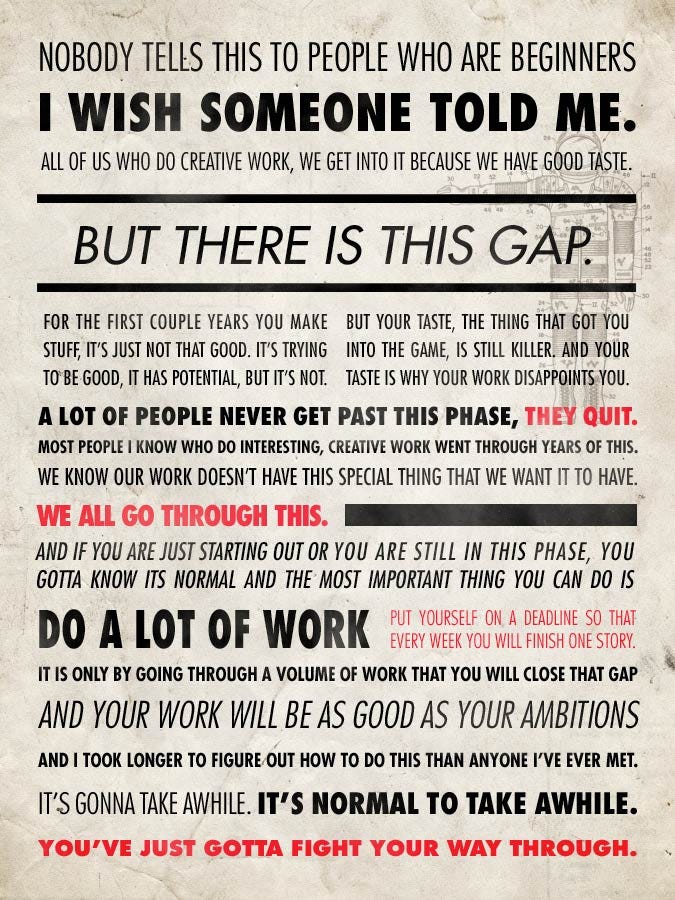Dear Insider,
Yesterday, over 120 participants turned up to learn how to draw tiny people! I am blown away by the response to this workshop. It is incredible to see so many people make space for drawing in their lives. And I am grateful that they would choose me as a guide in this journey.
In the video attached to this post, watch one of the several demos I did to explain my approach and technique.
The next workshop is on Saturday, 18 November. Remember, paying subscribers get FREE seats in all virtual workshops and events. Free readers, you will get the link later this week in another email. (Or, you can sign up to become Insiders and grab your free seat too!)
In today’s post, I want to answer an oft-asked question - “How do you develop a style?”
The SneakyArt (Insider) Post is written for paid subscribers and patrons of my work. Every Sunday, I offer a behind-the-scenes look at my latest projects, and share deeper thoughts from my journey as an artist and writer.
Obligatory Disclaimer
While this is an important subject, I hesitate to get into it.
I do not want to be the guy doing commentary, and I loathe the terms “should” and “must”. I never listen to anyone who tells me what to do. So I do not want to tell you what to do. Feel free to completely ignore me.
I only know what I know, which is less than what I think I know.
There. Now that I have disclaimed myself, let us proceed.
What is Style?
“Once, is a mistake. Twice, is an idea. Three times is style.” - Miles Davis
I share this quote before every workshop. Take care to not lose yourself in the pursuit of “eliminating mistakes”. Good art is not perfect art. In fact, perfect art does not actually exist. (Sorry, AI-bros.) What gives value to art is its humanity. This means human inspiration and skill but also all the stuff we call ‘mistakes’.
Some mistakes are not mistakes but preferences. Some mistakes are inclinations and idiosyncrasies. Some mistakes are the artist’s stubborn refusal to do otherwise. Some mistakes are a consequence of many subconscious influences that even the artist is not aware of, and that fade with changing circumstances.
The artist must be tapped into these mistakes and others. The artist must give them value before anyone else recognizes them. People don’t know.
This is my experience: Staying with your mistakes will give you good ideas. Staying with good ideas, working with them instead of against them, becomes the thing that people call style.
It is the fullest acknowledgment of your abilities and weaknesses, and an innate understanding of inclinations and disinclinations. It is the path you walk carrying all the things that are you.
It is not easy, but it is simple. It will take more time than you think, but less than you might imagine. You will know you have it when you cannot do otherwise. Your style is simply the most honest way that you create.
🎙 Listen to my interview on CBC Radio about making the leap from engineering to writing and art.
During my workshops, I also use a visual aid (below) to explain an important concept about style. I learned it during my Master’s education in mechanical engineering, when learning to design high-precision systems. No one was talking about drawing or style in that classroom. But like a lot of good ideas, it applies across many fields.
Can you tell the subtle difference between precision and accuracy?
Accuracy is how correct you are. Precision is how consistent you are. Many people confuse the two. They think they need to be exactly correct, i.e. accurate.
In my opinion, the job of the artist is precision.
Precision is the ability to be consistent, even in your mistakes. If you hit the dartboard at the same spot every time (bottom-right), you are precise but not accurate.
People who think in numbers, those who cannot think outside of numbers and formulae and algorithms, are unable to appreciate the gift of inaccurate precision.
But you must. The optimal state of humankind is not a machine.
I am reluctant to lead workshops. My usual refrain is this -
“None of this is new. People can learn it from anyone else too.”
While this is true (sigh), it is not a good reason. A lot of the important things in life are not actually secrets. Everyone has been looking for them, and finding them, and telling others about them. A lot of the important things in life are simple.
But just because they are simple does not make them easy.
I think of the difference between these words. Something easy can be accomplished without difficulty. If a thing is simple, it may still be very difficult to do, but you know how to go about doing it.
So: it is simple to draw. You just have to follow the lines. And some good advice. But it is not easy to do. It needs practice, deep thought, and a lot of time.
Maybe I can help.
This quote from Ira Glass (of the podcast, This American Life) has stayed with me for many years. Fight, my friends.
Thank you for your time and attention. I am glad for your support of my work.









